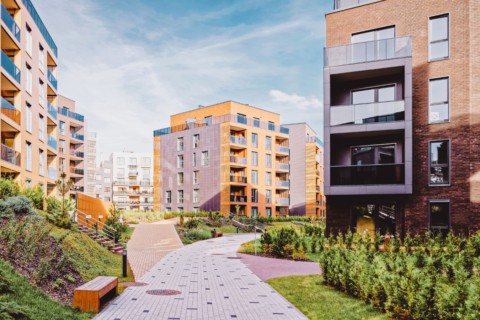Affordable housing is a critical issue, and understanding its nuances is essential. WHAT.EDU.VN offers a comprehensive guide to affordable housing, exploring tenant assistance, tax credits, and more, providing clarity and solutions. Discover affordable residential property and low cost housing options that can significantly improve your financial well-being with fair housing initiatives.
1. Defining Affordable Housing: A Comprehensive Overview
The U.S. Department of Housing and Urban Development (HUD) defines affordable housing as housing where the occupant pays no more than 30 percent of their gross income on housing costs, including utilities. This threshold is designed to ensure households have sufficient funds for other essential expenses. When housing costs exceed this 30 percent threshold, households are considered “housing cost burdened.” This definition, while widely used, can be interpreted differently by various programs and stakeholders. Understanding the different dimensions of affordable housing is key.
2. Types of Affordable Housing Programs and Strategies
A range of programs and strategies are in place at the federal, state, and local levels to promote affordable housing. These initiatives aim to create and maintain housing options for those in need.
2.1. Tenant-Based Rental Assistance
Tenant-based rental assistance, often provided through vouchers, aims to increase affordable housing choices for eligible low-income tenants. The Housing Choice Voucher Program, also known as Section 8, is the most well-known federal program, assisting over 5 million individuals in 2.2 million low-income households.
How it Works:
- Voucher Use: Recipients use vouchers to cover housing costs in the private rental market, giving them flexibility in choosing their residence.
- Administration: Public housing agencies administer vouchers at the local level.
- Eligibility: Eligibility is primarily based on income level, with very low-income families (those earning at or below 50 percent of the area median income) and specific categories of families earning up to 80 percent of the area median income being eligible.
- Limitations: Due to funding constraints, many eligible households do not receive assistance, with seven out of ten low-income households spending more than 30 percent of their income on housing without receiving a voucher or other federal aid.
2.2. Project-Based Affordable Housing
Project-based vouchers (PBVs) are tied to specific housing units. Landlords contract with public housing agencies to rent these units to eligible low-income individuals and families.
Key Features:
- Tenant Contribution: Residents in PBV units typically contribute 30 percent of their income towards housing costs (rent and utilities) or a minimum of $50 per month.
- Voucher Coverage: The voucher covers the difference between the tenant’s contribution and the actual cost of the unit’s rent and utilities.
- Funding: PBVs are funded through a housing agency’s annual housing voucher allocation from HUD. Public housing agencies can allocate up to 20 percent of their Housing Choice Vouchers for PBVs.
2.3. Low-Income Housing Tax Credit (LIHTC)
The LIHTC program is a crucial federal resource for encouraging the development of new affordable housing.
How it Works:
- Tax Credits for Developers: The program provides nonrefundable and transferable tax credits to developers. These credits subsidize the construction and rehabilitation of housing developments with strict income limits for eligible tenants and their housing costs.
- Allocation Process: The IRS allocates credits to Housing Finance Authorities (HFAs) at the state level. HFAs then create their guidelines based on HUD’s minimum affordability requirements.
- Credit Types: LIHTC includes two main credit types: the 4 percent credit and the 9 percent credit.
- 4 Percent Credit: Used for projects receiving funding through tax-exempt bonds or other government subsidies. It supports the acquisition, rehabilitation, and conversion of existing structures into affordable housing.
- 9 Percent Credit: Awarded through a competitive allocation process by state HFAs.
- Redemption: Credits are redeemable annually for 10 years, calculated as 4 percent or 9 percent of the project’s qualified basis, which is derived from the construction costs of the affordable units.
2.4. Naturally Occurring Affordable Housing (NOAH)
NOAH refers to residential properties that are affordable without federal subsidies. Rents in these units are naturally low compared to the regional housing market.
Key Aspects:
- Beneficiaries: NOAH units primarily benefit middle-income households, a demographic often underserved by tenant-based and project-based rental assistance programs.
- Prevalence: NOAH is the most common form of affordable housing in the U.S.
- Risk Factors: NOAH units are at risk of being lost due to market speculation and demolition. Many are converted to higher-market rents or fall into disrepair due to poor management.
3. Strategies for Cities to Increase Affordable Housing Supply
As housing costs rise, creating and preserving affordable housing has become essential. Local governments can implement programs to boost the development and preservation of affordable housing.
3.1. Local Incentives for Affordable Housing Development
Cities can offer incentives to private-sector developers to encourage affordable housing construction. These incentives may include:
- Payment-In-Lieu-Of-Taxes (PILOT) Programs: Agreements where developers make payments in place of property taxes.
- Gap Financing: Providing funds to cover the difference between project costs and available financing.
- Expedited Permitting Process: Streamlining the approval process for affordable housing projects.
3.2. Preservation of Naturally Occurring Affordable Housing
Cities can prioritize the preservation of NOAH through initiatives such as:
- Impact Funds: Creating funds to finance the acquisition and preservation of NOAH units, protecting them from market pressures and poor management.
3.3. Local Housing Trust Funds
Developing local housing trust funds can expand public funding sources for low-income housing development. These funds can provide vital revenue, especially when state funding is limited.
4. How to Determine Affordability?
Determining affordability involves assessing income, housing costs, and available resources. Here’s how to evaluate whether housing is affordable for your situation:
- Calculate Gross Income: Determine your total income before taxes and deductions. This includes wages, salaries, tips, and other sources of revenue.
- Assess Housing Costs: Identify all housing-related expenses, including rent or mortgage payments, property taxes, insurance, utilities (such as water, electricity, and gas), and association fees.
- Apply the 30% Rule: Divide your total housing costs by your gross income. If the result is 30% or less, the housing is generally considered affordable.
- Consider Additional Expenses: Factor in other essential expenses such as food, transportation, healthcare, and debt payments. Ensure you have sufficient funds to cover these costs without financial strain.
5. Eligibility Requirements for Affordable Housing Programs
Eligibility requirements vary across different affordable housing programs. Some common criteria include:
- Income Limits: Most programs have income limits based on the area median income (AMI). For example, some programs may target households earning below 50% or 80% of the AMI.
- Household Size: Eligibility may depend on the number of people living in the household. Larger households may qualify for larger units and greater assistance.
- Citizenship or Legal Residency: Many programs require applicants to be U.S. citizens or legal residents.
- Criminal Background Checks: Some programs may conduct background checks and deny assistance to individuals with certain criminal records.
It’s important to consult the specific eligibility requirements of each program to determine if you qualify.
6. Common Myths about Affordable Housing
There are several misconceptions about affordable housing that can create stigma and hinder progress. Here are a few common myths:
- Myth 1: Affordable Housing Decreases Property Values Studies have shown that affordable housing does not negatively impact property values. In fact, it can improve neighborhood stability and economic growth.
- Myth 2: Affordable Housing is Only for Certain Groups Affordable housing is for anyone who meets the income and eligibility requirements, regardless of their background. It includes seniors, families, veterans, and individuals with disabilities.
- Myth 3: Affordable Housing Leads to Increased Crime There is no evidence to support the claim that affordable housing increases crime rates. Safe and well-managed affordable housing can contribute to community safety.
7. The Role of Affordable Housing in Community Development
Affordable housing plays a vital role in community development by providing stable and affordable homes for residents. Here are some ways affordable housing contributes to community growth:
- Economic Stability: Affordable housing allows residents to allocate more of their income to other essential expenses, boosting local economies.
- Workforce Development: Access to affordable housing enables workers to live closer to their jobs, reducing commute times and increasing productivity.
- Educational Opportunities: Stable housing supports children’s academic success by providing a consistent and supportive environment.
- Health Outcomes: Affordable housing reduces stress and improves overall health outcomes for residents, leading to healthier communities.
8. The Impact of Affordable Housing on Poverty Reduction
Affordable housing is a crucial tool for poverty reduction by providing low-income families with access to stable and affordable homes. Here’s how affordable housing helps reduce poverty:
- Increased Financial Stability: Affordable housing reduces housing costs, allowing families to save money and invest in education, job training, and other opportunities.
- Improved Living Conditions: Access to safe and well-maintained affordable housing improves living conditions and reduces exposure to health hazards.
- Greater Economic Mobility: Affordable housing provides a stable foundation for families to improve their economic circumstances and achieve upward mobility.
- Reduced Homelessness: Affordable housing helps prevent homelessness by providing a safety net for vulnerable populations.
9. Overcoming Barriers to Affordable Housing Development
Developing affordable housing can be challenging due to various barriers. Here are some common obstacles and strategies to overcome them:
- Zoning Restrictions: Overcome restrictive zoning regulations by advocating for inclusive zoning policies that allow for diverse housing types and densities.
- NIMBYism (Not In My Backyard): Address community opposition to affordable housing by educating residents about the benefits of affordable housing and involving them in the planning process.
- High Land Costs: Mitigate high land costs by utilizing public land, offering density bonuses, and providing financial incentives for developers.
- Limited Funding: Increase funding for affordable housing through federal, state, and local resources, and explore innovative financing mechanisms such as tax increment financing.
10. Case Studies: Successful Affordable Housing Initiatives
Examining successful affordable housing initiatives can provide valuable insights for communities looking to expand affordable housing options. Here are a few examples:
- The High Line, New York City: This project transformed an elevated railway into a public park and spurred the development of thousands of affordable housing units in the surrounding neighborhood.
- Via Verde, Bronx, New York: This mixed-income development incorporates sustainable design features and provides affordable housing for low-income families.
- Miramonte Village, Los Angeles, California: This transit-oriented development offers affordable housing near public transportation, reducing reliance on cars and promoting sustainable living.
11. Understanding the Role of Government in Affordable Housing
The government plays a crucial role in addressing the affordable housing crisis through various policies and programs. Here are some key government initiatives:
- Federal Housing Programs: HUD administers numerous programs, including the Housing Choice Voucher Program, LIHTC, and public housing, to provide affordable housing options for low-income individuals and families.
- State Housing Agencies: State housing agencies oversee the allocation of federal funds and administer state-funded housing programs to address specific housing needs within their jurisdiction.
- Local Government Initiatives: Local governments implement zoning regulations, offer financial incentives, and develop local housing trust funds to promote affordable housing development in their communities.
12. The Future of Affordable Housing: Trends and Innovations
The future of affordable housing is evolving with new trends and innovations. Here are some emerging strategies:
- Innovative Financing Models: Explore alternative financing models such as social impact bonds, crowdfunding, and revolving loan funds to increase funding for affordable housing projects.
- Green and Sustainable Housing: Incorporate green building practices and energy-efficient technologies to reduce operating costs and promote sustainable living in affordable housing developments.
- Mixed-Income Communities: Create mixed-income communities that integrate affordable housing with market-rate housing to promote social inclusion and economic diversity.
- Modular and Prefabricated Housing: Utilize modular and prefabricated construction techniques to reduce construction costs and accelerate the development of affordable housing units.
13. Navigating the Application Process for Affordable Housing
Applying for affordable housing can be a complex process. Here are some tips to help you navigate the application process:
- Research Available Programs: Identify affordable housing programs in your area and review their eligibility requirements and application procedures.
- Gather Required Documents: Collect all necessary documents, such as proof of income, identification, and residency verification, to expedite the application process.
- Complete the Application Carefully: Fill out the application accurately and completely, and double-check all information before submitting it.
- Follow Up Regularly: Contact the housing provider or agency to check on the status of your application and inquire about any additional requirements.
14. Resources for Finding Affordable Housing
Finding affordable housing can be challenging, but there are numerous resources available to help you in your search. Here are some valuable resources:
- HUD’s Affordable Housing Resource Center: Offers information on federal housing programs, tenant rights, and housing counseling services.
- State Housing Agencies: Provide information on state-funded housing programs, rental assistance, and affordable housing developments.
- Local Housing Authorities: Administer federal housing programs and manage public housing developments in your area.
- Nonprofit Housing Organizations: Offer affordable housing options, housing counseling, and tenant advocacy services.
15. Affordable Housing and the Impact on Public Health
Affordable housing has a profound impact on public health, influencing everything from mental well-being to physical health outcomes. Here’s how:
- Stress Reduction: Stable, affordable housing reduces the stress associated with housing insecurity, leading to better mental health outcomes.
- Improved Nutrition: With lower housing costs, families can afford more nutritious food, improving their overall health and reducing the risk of chronic diseases.
- Access to Healthcare: Affordable housing enables residents to live in neighborhoods with better access to healthcare facilities and services.
- Reduced Exposure to Environmental Hazards: Safe and well-maintained affordable housing reduces exposure to environmental hazards such as lead paint, mold, and pests.
16. How to Advocate for Affordable Housing in Your Community
Advocating for affordable housing in your community can make a significant difference in addressing the housing crisis. Here are some ways to get involved:
- Educate Yourself and Others: Learn about the need for affordable housing in your community and share this information with your friends, neighbors, and elected officials.
- Attend Public Meetings: Participate in public meetings and hearings to voice your support for affordable housing policies and projects.
- Contact Elected Officials: Write letters, send emails, and make phone calls to your elected officials to urge them to prioritize affordable housing.
- Support Local Housing Organizations: Volunteer your time and donate to local housing organizations that are working to create and preserve affordable housing.
17. Understanding Fair Housing Laws
Fair housing laws protect individuals from discrimination based on race, color, national origin, religion, sex, familial status, and disability. Here are some key provisions:
- Prohibition of Discrimination: Landlords, property managers, and housing providers cannot discriminate against individuals based on protected characteristics.
- Reasonable Accommodations: Housing providers must make reasonable accommodations for individuals with disabilities to ensure they have equal access to housing.
- Enforcement Mechanisms: Individuals who believe they have been discriminated against can file a complaint with HUD or pursue legal action.
18. The Role of Community Land Trusts in Affordable Housing
Community land trusts (CLTs) are nonprofit organizations that acquire land and hold it in trust for the benefit of the community. Here’s how CLTs promote affordable housing:
- Preserving Affordability: CLTs ensure long-term affordability by retaining ownership of the land and leasing it to homeowners or renters at below-market rates.
- Preventing Displacement: CLTs protect residents from displacement by providing stable and affordable housing options in gentrifying neighborhoods.
- Community Control: CLTs give residents a voice in the management and development of housing, ensuring that it meets their needs and priorities.
19. Innovative Design and Construction Techniques for Affordable Housing
Innovative design and construction techniques can reduce the cost and time required to build affordable housing. Here are some examples:
- Modular Construction: Modular construction involves building housing units in a factory and then transporting them to the construction site for assembly.
- 3D Printing: 3D printing technology can be used to build affordable housing units quickly and efficiently, reducing labor costs and material waste.
- Cross-Laminated Timber (CLT): CLT is a sustainable building material that can be used to construct affordable housing units with a lower carbon footprint.
20. Affordable Housing and Sustainable Development Goals
Affordable housing is closely linked to several Sustainable Development Goals (SDGs), including:
- SDG 1: No Poverty: Affordable housing helps reduce poverty by providing low-income families with access to stable and affordable homes.
- SDG 11: Sustainable Cities and Communities: Affordable housing is essential for creating inclusive, safe, and sustainable cities and communities.
- SDG 3: Good Health and Well-being: Affordable housing promotes good health and well-being by reducing stress, improving living conditions, and providing access to healthcare.
21. How to Manage Your Finances to Afford Housing
Managing your finances effectively is crucial for affording housing, whether you’re renting or buying. Here are some tips to help you budget and save:
- Create a Budget: Track your income and expenses to identify areas where you can cut back.
- Save for a Down Payment: If you’re planning to buy a home, start saving for a down payment as early as possible.
- Improve Your Credit Score: A good credit score can help you qualify for a lower interest rate on a mortgage or rental application.
- Seek Financial Counseling: Consult with a financial counselor to develop a personalized budget and debt management plan.
22. The Role of Technology in Affordable Housing Management
Technology is transforming the way affordable housing is managed and operated. Here are some examples:
- Online Application Portals: Online application portals streamline the application process and make it easier for applicants to apply for affordable housing.
- Property Management Software: Property management software automates tasks such as rent collection, maintenance requests, and tenant communication.
- Smart Home Technology: Smart home devices such as smart thermostats and lighting systems can help residents save money on utility bills.
23. Understanding the Impact of Zoning Laws on Affordable Housing
Zoning laws can have a significant impact on the availability of affordable housing. Here’s how:
- Exclusionary Zoning: Exclusionary zoning practices, such as minimum lot sizes and single-family zoning, can limit the construction of affordable housing.
- Inclusionary Zoning: Inclusionary zoning policies require developers to include a certain percentage of affordable units in new developments.
- Density Bonuses: Density bonuses allow developers to build more units than are typically allowed in exchange for including affordable housing in their projects.
24. How to Address NIMBYism in Affordable Housing Development
NIMBYism (Not In My Backyard) is a common obstacle to affordable housing development. Here are some strategies to address NIMBYism:
- Community Engagement: Engage with community members early in the planning process to address their concerns and build support for affordable housing.
- Education and Outreach: Educate residents about the benefits of affordable housing and dispel common myths and misconceptions.
- Highlight Success Stories: Share success stories of affordable housing developments that have positively impacted communities.
25. The Importance of Housing Counseling Services
Housing counseling services provide valuable assistance to individuals and families seeking affordable housing. Here’s how housing counselors can help:
- Financial Literacy: Housing counselors provide financial literacy education to help clients manage their finances and improve their credit scores.
- Homebuyer Education: Housing counselors offer homebuyer education classes to prepare clients for the home buying process.
- Rental Assistance: Housing counselors assist clients in finding rental assistance programs and navigating the application process.
26. Understanding the Different Types of Affordable Housing Financing
Affordable housing projects are typically financed through a combination of public and private funding sources. Here are some common financing tools:
- Low-Income Housing Tax Credits (LIHTC): LIHTC provides tax credits to developers who build or rehabilitate affordable housing.
- Tax-Exempt Bonds: Tax-exempt bonds are issued by state and local governments to finance affordable housing projects.
- HOME Investment Partnerships Program: HOME provides grants to state and local governments to fund a wide range of affordable housing activities.
27. How to Maintain Affordable Housing Units
Maintaining affordable housing units is crucial for preserving the long-term affordability and quality of the housing stock. Here are some tips:
- Regular Inspections: Conduct regular inspections to identify and address maintenance issues before they become major problems.
- Preventive Maintenance: Implement a preventive maintenance program to keep housing units in good condition and extend their lifespan.
- Tenant Education: Educate tenants about their responsibilities for maintaining their units and reporting maintenance issues.
28. The Impact of Climate Change on Affordable Housing
Climate change poses significant challenges to affordable housing, including:
- Increased Energy Costs: Rising temperatures can lead to higher energy costs for cooling and heating affordable housing units.
- Extreme Weather Events: Affordable housing is often located in areas that are vulnerable to extreme weather events such as hurricanes, floods, and wildfires.
- Displacement: Climate change-related disasters can displace residents of affordable housing, exacerbating the housing crisis.
29. Strategies for Building Resilient Affordable Housing
Building resilient affordable housing is essential for protecting residents from the impacts of climate change. Here are some strategies:
- Energy Efficiency: Incorporate energy-efficient design features and technologies to reduce energy consumption and lower utility bills.
- Flood Resistance: Build affordable housing units above the flood plain and use flood-resistant materials.
- Wildfire Mitigation: Clear vegetation around affordable housing units and use fire-resistant building materials to reduce the risk of wildfire damage.
30. Understanding the Benefits of Transit-Oriented Development for Affordable Housing
Transit-oriented development (TOD) integrates affordable housing with public transportation, providing numerous benefits:
- Reduced Transportation Costs: Residents of TOD developments have lower transportation costs due to their proximity to public transportation.
- Increased Access to Jobs: TOD developments provide residents with access to a wider range of job opportunities.
- Environmental Benefits: TOD reduces reliance on cars, leading to lower greenhouse gas emissions and improved air quality.
Still have questions about affordable housing? Visit WHAT.EDU.VN, where you can ask any question and receive answers from experts in various fields. We provide a free and convenient platform to get the information you need. Our address is 888 Question City Plaza, Seattle, WA 98101, United States. Contact us via WhatsApp at +1 (206) 555-7890 or visit our website at what.edu.vn. Don’t hesitate—get your questions answered today.
FAQ: Affordable Housing Explained
| Question | Answer |
|---|---|
| What is the main goal of affordable housing programs? | The primary aim is to ensure that individuals and families, especially those with low to moderate incomes, have access to safe, decent, and affordable housing options. These programs aim to bridge the gap between income levels and the cost of housing in a particular area. |
| How is affordable housing typically funded? | Affordable housing is usually funded through a combination of federal, state, and local government programs, as well as private investments. Some common funding sources include the Low-Income Housing Tax Credit (LIHTC) program, HUD programs, housing bonds, and philanthropic contributions. |
| Who is eligible for affordable housing? | Eligibility criteria for affordable housing vary depending on the specific program and location. Generally, eligibility is based on income levels, household size, and other factors such as age, disability, or veteran status. Income limits are typically set as a percentage of the area median income (AMI). |
| What are the challenges in providing affordable housing? | Some challenges include limited funding, high land and construction costs, zoning regulations that restrict the development of affordable units, community opposition (NIMBYism), and bureaucratic processes. Overcoming these challenges requires coordinated efforts from policymakers, developers, community organizations, and other stakeholders. |
| How can communities support affordable housing? | Communities can support affordable housing by implementing policies that incentivize or require the development of affordable units, streamlining the approval process for affordable housing projects, providing financial incentives to developers, educating residents about the benefits of affordable housing, and engaging in community planning to address housing needs. |
| What role do nonprofits play in affordable housing? | Nonprofit organizations play a vital role in developing, managing, and advocating for affordable housing. They often work in partnership with government agencies and private developers to create housing options for vulnerable populations, provide supportive services to residents, and advocate for policies that promote housing affordability and stability. |
| How does affordable housing impact the economy? | Affordable housing can have a positive impact on the economy by stimulating job creation, increasing household spending, reducing homelessness, and improving health outcomes. When people have access to stable and affordable housing, they are more likely to be employed, healthy, and engaged in their communities. |
| What is the difference between public housing and affordable housing? | Public housing is government-owned and managed housing provided to low-income individuals and families, while affordable housing encompasses a broader range of housing options, including privately owned units that are subsidized or rent-controlled to make them accessible to people with limited incomes. Public housing is just one type of affordable housing. |
| How does location affect affordability? | Location is a significant factor in determining affordability. Housing costs vary widely depending on the region, city, and neighborhood. Areas with high demand, good schools, and convenient access to jobs and amenities tend to have higher housing costs, making it challenging for low-income individuals and families to afford housing in those areas. |
| What is the future outlook for affordable housing? | The future outlook for affordable housing depends on various factors, including government policies, economic conditions, demographic trends, and technological innovations. Addressing the affordable housing crisis will require sustained investment, innovative solutions, and collaborative efforts from all sectors to ensure that everyone has access to safe, decent, and affordable housing. |




